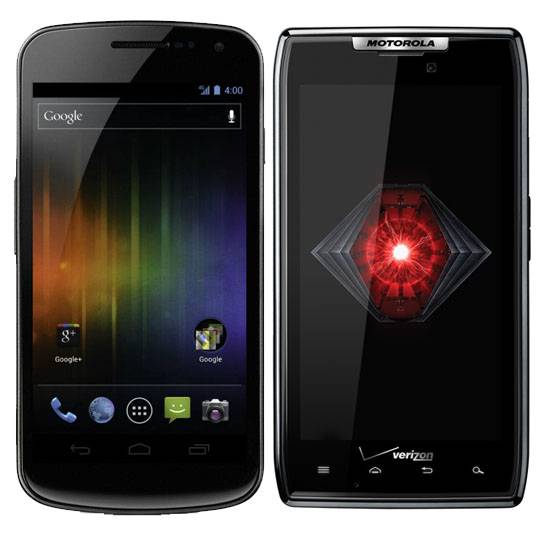
We saw a couple of big announcements in the Android world yesterday: Motorola’s new flagship DROID RAZR and the Samsung Galaxy Nexus. Since Verizon customers at least may soon have to make a hard choice, we’ve put up a direct comparison between the two devices. Which one will reign supreme at the top of the Android heap?
Screen
Both devices feature a Super AMOLED screen, which by our reckoning is just about the best out there ate the moment. Technically the Galaxy Nexus’ screen is larger at 4.65 inches to the DROID RAZR’s 4.3, but as we reported earlier, that extra real-estate will mostly be used by Ice Cream Sandwich’s soft navigation buttons, and since the RAZR has the standard capacitive buttons, I invite you to judge for yourself which is better. What doesn’t need any judgement is the resolution: the Galaxy Nexus features a 1280 x 720 screen, while the DROID RAZR uses a less sharp but still impressive 960 x 540. This is a big deal for resolution junkies, but honestly, many won’t be able to tell the difference – if you’ve never found yourself counting pixels on your phone’s screen before, rest assured that either device will blow you away. The choice here depends on whether you prefer the standard capacitive navigation buttons or Ice Cream Sandwich’s virtual ones.
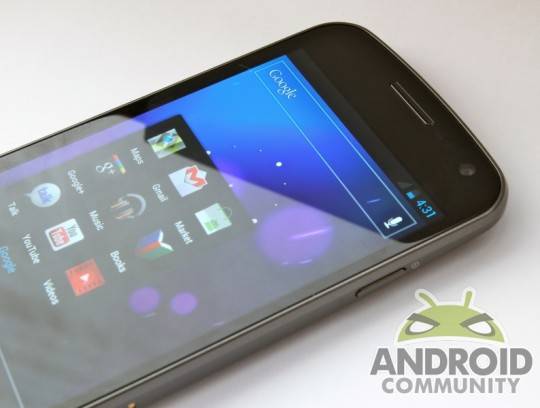
Processor and RAM
The Galaxy Nexus and the DROID RAZR both use a dual-core 1.2Ghz processor and a full gigabyte of memory, matching up with the latest of high-end Android smartphones. But here the Nexus has a slight edge: the Samsung phone uses the TI OMAP4460 model, while the RAZR uses OMAP4430. The difference is in the graphics processor, and on that score, the Nexus wins out. The difference between the two is subtle, but definitely quantifiable. Also, the 4460 is designed to run at clocks speeds of up to 1.5GHz, so overclockers should have an easy time getting even more speed out of the Galaxy Nexus. Both phones will start at 16GB of internal memory, with some models of the Nexus getting a bump up to 32GB.
Construction
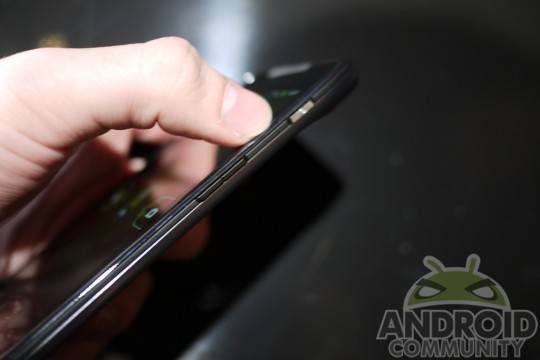
As much as we love Samsung’s Galaxy line of phones, the DROID RAZR is undeniably slick, with its exposed 7.1mm steel frame and Kevlar accents. The Motorola phone will turn heads wherever it goes, whereas the Galaxy Nexus just looks like a Galaxy S II with some curvy design elements. For strength and style the RAZR wins out, but don’t forget that it’s sacrificing a removable battery. Both phones use Gorilla Glass for their large screens, so durability shouldn’t be a problem. Both phones will have HSPA+ or LTE depending upon which market they’re being sold in – the international version of the DROID RAZR will simply be known as the Motorola RAZR.
Camera

Samsung will shout to the heavens that their 5 megapixel CMOS sensor is superior to other 8 megapixel phone cameras like the DROID RAZR’s, but until we can hold both phones in our hands and do some direct comparisons, we’re going to have to give this one to Motorola. We’ve taken a few shots with both phones, and while each is a solid shooter, in an ideal situation I want as many pixels as I can get. Assuming that the DROID RAZR will have access to Ice Cream Sandwich’s enhanced camera software at some point, it should be able to best the Galaxy Nexus.
Battery
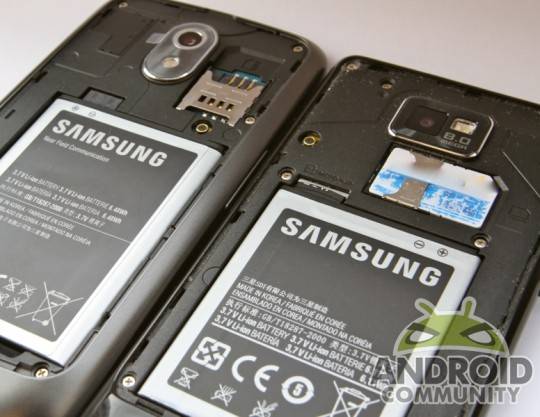
Technically speaking, the DROID RAZR has the larger battery of the two, at 1800 mAh to 1750 mAh. But I’m giving this one to the Galaxy Nexus on account of its being a traditional removable battery. The DROID RAZR’s will be non-removable. Motorola can say all they like about extended battery managers in the software (and the other customizations they add aren’t going to help), but at the end of the day, nothing’s going to beat a quick battery swap when you’re on the run.
Software
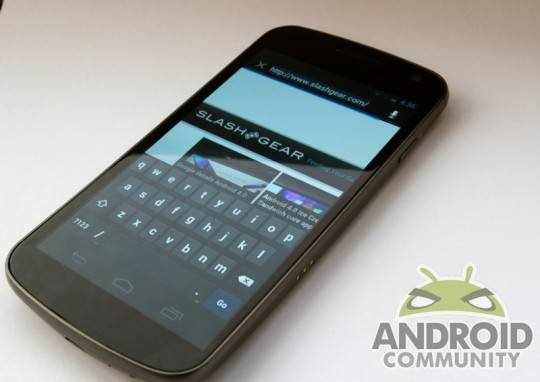
It hardly seems fair to compare a developer phone to a standard Android handset, but given Motorola’s awful track record when it comes to updates, it should be an important factor in your purchasing decision. The simple fact is that the DROID RAZR won’t be on the Galaxy Nexus’ level of Ice Cream Sandwich for several months at the least, and when it finally is upgraded, you can rely on Motorola to supply their generally undesirable “UI enhancements” and slow down the experience.
Motorola is touting their new MotoCast as a cloud initiative, but in reality, it’s remote file access. While that’s certainly appreciated, it requires you to keep a computer on at home at all times – something that might not be typical in a laptop-dominated market. The fact that much of its functionality is duplicated with real cloud services like Google Music, Google Docs and Dropbox doesn’t help. The rest of Motorola’s customizations aren’t exactly bad, but they do slow down Android, and most of us would prefer a “clean” Android experience on the Nexus.
Even worse, the mod community probably won’t be able to bring Ice Cream Sandwich any sooner, since Motorola and Verizon have made the infuriating decision to lock the bootloader. That means that custom ROMs will likely be stuck with the latest kernel that Motorola provides, and you won’t see Ice Cream Sandwich on the DROID RAZR any sooner than Motorola wants you to. The Galaxy Nexus will have better software from day one, and unless Motorola shows a shocking change in corporate policy, it’s likely to stay that way.
Conclusion
Do you even need to ask? For superior software, an incredible screen resolution, a slight edge in hardware and a removable battery, the Galaxy Nexus wins in a knockout. If hardware was the only consideration the DROID RAZR might have held up on style alone, but the locked bootloader means RAZR owners won’t be getting Ice Cream Sandwich in any capacity for several months at the least. Since the leaked price for the Galaxy Nexus matches the $299 MSRP of the DROID RAZR, there’s just no reason not to go with Google’s official developer phone, at least until we get both of them in for a full review. Now we’ve just got to wait for both of them to become available.
Check out our hands-on looks at the Galaxy Nexus and Ice Cream Sandwich below:
Galaxy Nexus Hands-on
[vms 55018e2a459517fdb40e]
Ice Cream Sandwich Hands-on
[vms 4b1be110b7bf70c8362d]
And our hands-on of the Motorola DROID RAZR:
Motorola DROID RAZR hands-on:
[vms 9b2541ff53db39f407a9]










Why did they have to release a 5mpix and no external memory! It would have made the choice so much easier 🙂
it does have external memory, and MP number does not mean anything against quality. There are several examples of a 5 MP camera shooting better pics than a low end 8 MP
Exactly where did you see that the Nexus has external storage? Everything I’ve seen says 16 or 32 GB with no mention made of any removable memory.
He’s right about a 5MP camera potentially being better than an 8MP camera. There’s a certain point when cramming more pixels in doesn’t make for a better photo.
As far as the external memory, that’s just crazy talk, your right about 16GB and 32GB being the options.
dont forget that Moto already said they are using the same 8mp camera that’s already available in the Droid X for the Droid Razr, And that Camera sucks.
Not the same camera. And it’s the software that sucks(slow to focus in low light), not the camera hardware. Software can be fixed. The RAZR probably has the same camera as the Bionic which is the Omnivison 8820(BSI sensor). When the 8820 was announced last Nov, it was speculated that it would be the IPhone5 camera as Omnivision currently supplies the IP4 camera. However, apple switched to Sony as the camera supplier for the 4S.
OK. As we all know, Verizon and Motorola do a great job of crippling the Android OS. The RAZR is being released with hardware buttons, yet ICS, ditched hardware buttons. So what happens when a device that has hardware buttons, gets the ICS update. Not good, I imagine. Either you now have 7+ buttons or the OEM’s will disable ICS’s, on screen buttons, in favor of hardware buttons. As a result, you will not a get a true ICS experience. I suggest get the Galaxy Nexus or wait until ICS powered phones are released.
you can toggle the on-screen buttons
They will obviously disable the on-screen buttons. You can call it “not a true ICS experience” all you want, but it’s really not a big deal.
I still want to see the Vigor. HTC please save us from the pitfalls of both of these phones!!!
Is that a sim card slot on the Galaxy Nexus…
Very well could be since VZW’s LTE uses SIM cards…if that’s the VZW version.
Nope, no removable storage on the nexus. Which doesn’t bother me at all. I have 16 gb on my OG Droid and I’ve never removed the memory card. 32 should do me just fine. I guess some of you never read the memo. The Nexus will not have bloat ware on Verizon or any other carrier. Straight up ICS. I personally think it is quite the phone, and anxiously wait for the day I can order one!
But I like the Razr so much more.
LOL at all the people saying they can’t get the Galaxy Nexus just because it doesn’t have removable storage. I’ve got a friggen HTC Sensation with a pathetic 1 GB of onboard storage and a measly 8 GB memory card, and I would kill for 16 GB of onboard memory. Hell, I’ve managed to live with the limited storage I have and I have way less than the Galaxy Nexus. How much crap do you people have on your phones? 32 GB is like a supertanker compared to my cargo container.
The Razr certainly has a nice design, but as I’ve learned with my Sensation (another phone of 2011 that really knocked it out of the park with design), that perk only lasts so long if it isn’t backed up with substance (performance). Not that the Razr won’t have substance, but the Galaxy Nexus just clearly will have that much more and makes it the winner.
If we don’t get ICS ROMs for the Sensation at the latest by January, and if the Galaxy Nexus gets good reviews, I’ll be happy to jump ship to the new king of Androids.
This is the first article I have read which stated that Galaxy Nexus has Gorilla Glass (which is surprising since the Nexus S had a similar shaped screen which didn’t allow it to have Gorilla Glass), has this been confirmed?
Wondering the exact same thing. No answer in two days?
This report is wrong. The Galaxy Nexus will not have gorilla glass.
This reviewer does know there isn’t any REMOVABLE memory for the Nexus Prime…right?
So how can it win hands down when I can potentially put a 64gb card one day on top of the 16gb internal memory???
In fact, the reviewer swung and WHIFFED on the Moto remote service part. It’s not for the typical user – IT’S FOR THE BUSINESS USER!!! All of this is for the business user. Rarely do folks wanna lug around a laptop from work. They can now not only remotely connect easily, but transfer files without having to pay for a service to do so or confuse themselves w/the free routes (business folks get easily confused…)
This review should have been more about “do you want a business phone, or a rooting phone?” instead of “do you want a phone that you wanna root today…or one you gotta wait till tomorrow to root?”
This looks removable to me: http://www.engadget.com/2011/10/20/behind-the-glass-a-detailed-tour-inside-the-samsung-galaxy-nexu/
What does a removable SIM card and battery have to do with removable memory?
your very very wrong! the phone must support 64gb mem and im pretty sure it does not.If you have built in memory its faster so if the phone has 32gb of built in memory its better than a phone that has support for only 32gb removable memory.
@Michael, it is very clear you have little knowledge of cameras. A larger pixel count on such a small sensor will actually degrade image quality. packing more pixels does not improve picture quality. Using a better sensor and lens does.
For a second there it sounded like the Galaxy Nexus runs on Ice Cream!!! That made me lol.
Please update your specs. Motorola has confirmed Razr will have TI OMAP 4460.
Also, another benefit to Razr, is that it is more likely to be offered as a handset for companies requiring higher security. I can guarantee the IT department will never offer that Galaxy Nexus, but the Razr, possibly.
Nope, no, nada, can’t remove the battery, can’t have my cash. I want a removable and replaceable battery. You can give me the best features 10 years ahead, but without the ability to change out a battery-“its a no fly zone”. Sorry Moto not this time
No removable sd. Can’t have my cash sorry sammy.
when u have 32 gb why would u want it
Galaxy Nexus does not use gorilla glass uses “Fortified Glass”
Nexus is lacking HDMI output. A deal breaker for me, and I expect others.
wow… really is it really that big of a deal?
@820325611c776700a6410aad591fec16:disqus ……….Hear this……My best friend’s mom makes $ 69 an hour on the computer. She has been out of job for 11 months but last month her check was $ 6623 just working on the computer for a few hours..Read about it here.....http://www.BestJob….